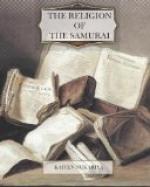[FN#101] Shi-seki-shu-ran.
[FN#102] In-gen (1654-1673) came over with Ta-Mei (Dai-bi, died 1673), Hwui Lin (E-rin died 1681), Tuh Chan (Doku-tan, died 1706), and others. For the life of In-gen: see Zoku-ko-shu-den and Kaku-shu-ko-yo.
[FN#103] Tsih Fei (Soku-hi died 1671), Muh Ngan (Moku-an died 1684), Kao Tsuen (Ko-sen died 1695), the author of Fu-so-zen-rin-so-bo-den, To-koku-ko-so-den, and Sen-un-shu, are best known.
[FN#104] This is a sub-sect of the Rin Zai School, as shown in the following table:
Table of the transmission of zen from China to Japan.
1. Bodhidharma. 2. Hwui Ko (E-ka). 3.
San Tsang (So-san). 4. Tao Sin (Do-shin). 5.
Hung Jan (Ko nin). —–The northern
sect
6. Shang Siu (Jin-shu).
—–The Southern sect
6. Hwui Nang (E-no).
—–The rin
zai school.
7. Nan Yoh
(Nan-gaku).
—–10.
Gi-ku.
—–11.
Lin Tsi (Rin-zai).
—–21.
Yuen Wu (En-go).
—–22.
Fuh Hai (Bukkai).
—–28.
Kaku-a.
—–The
O baku school.
42.
In-gen.
—–25.
Hti Ngan (Kyo-an).
—–26.
Ei-sai.
—–The so
to school.
7. Tsing
Yuen (Sei-gen).
—–8.
Shih Teu (Seki-to).
—–11.
Tung Shan (To-zan).
—–23.
Ju Tsing (Nyo-jo).
—–24.
Do-gen.
The O Baku School is the amalgamation of Zen and the worship of Amitabha, and different from the other two schools. The statistics for 1911 give the following figures:
The Number of Temples:
The So To School 14,255
The Rin Zai School 6,128
The O Baku School 546
The Number of Teachers:




